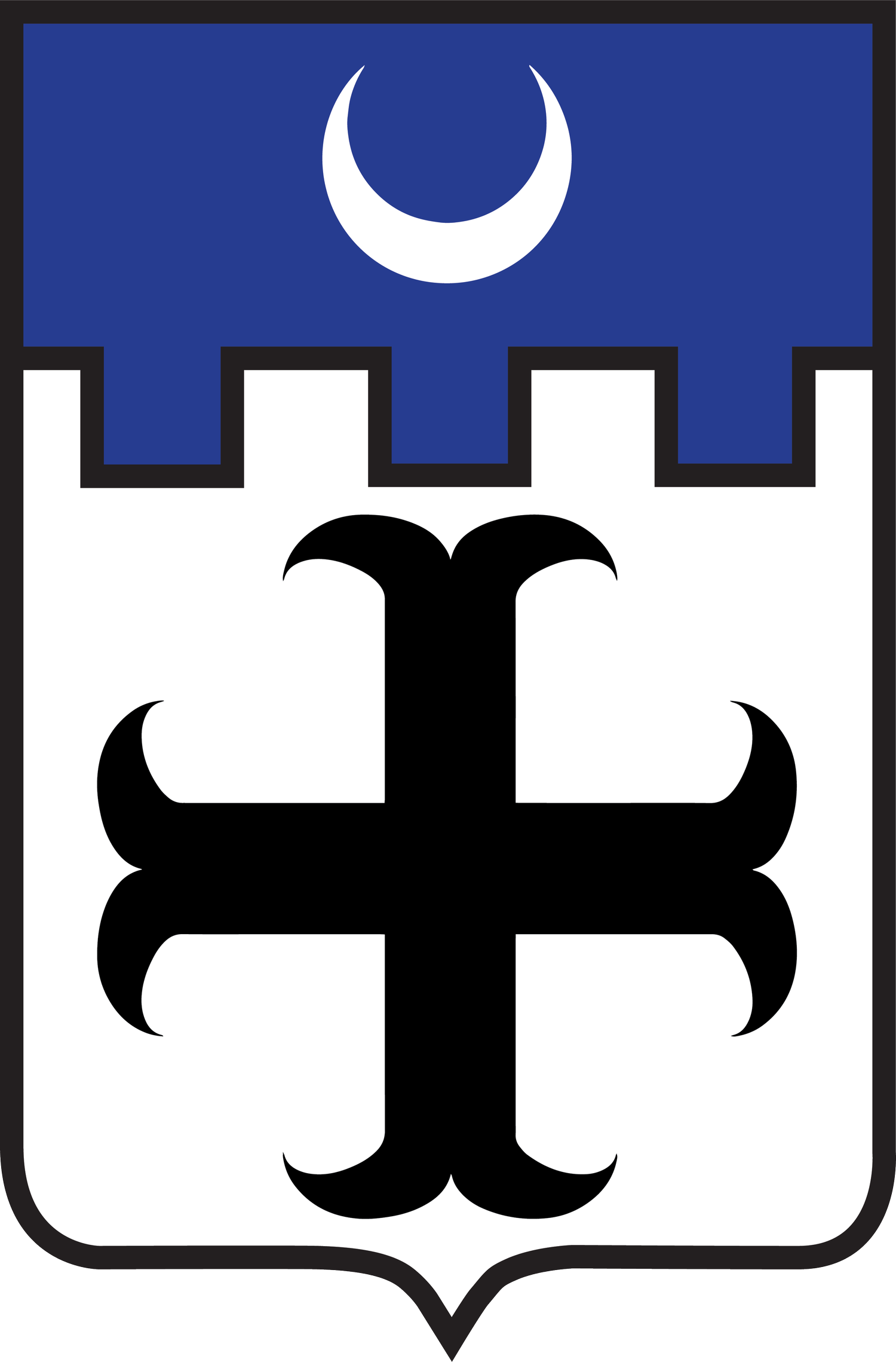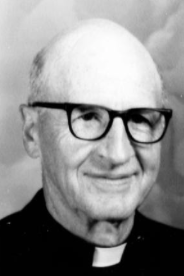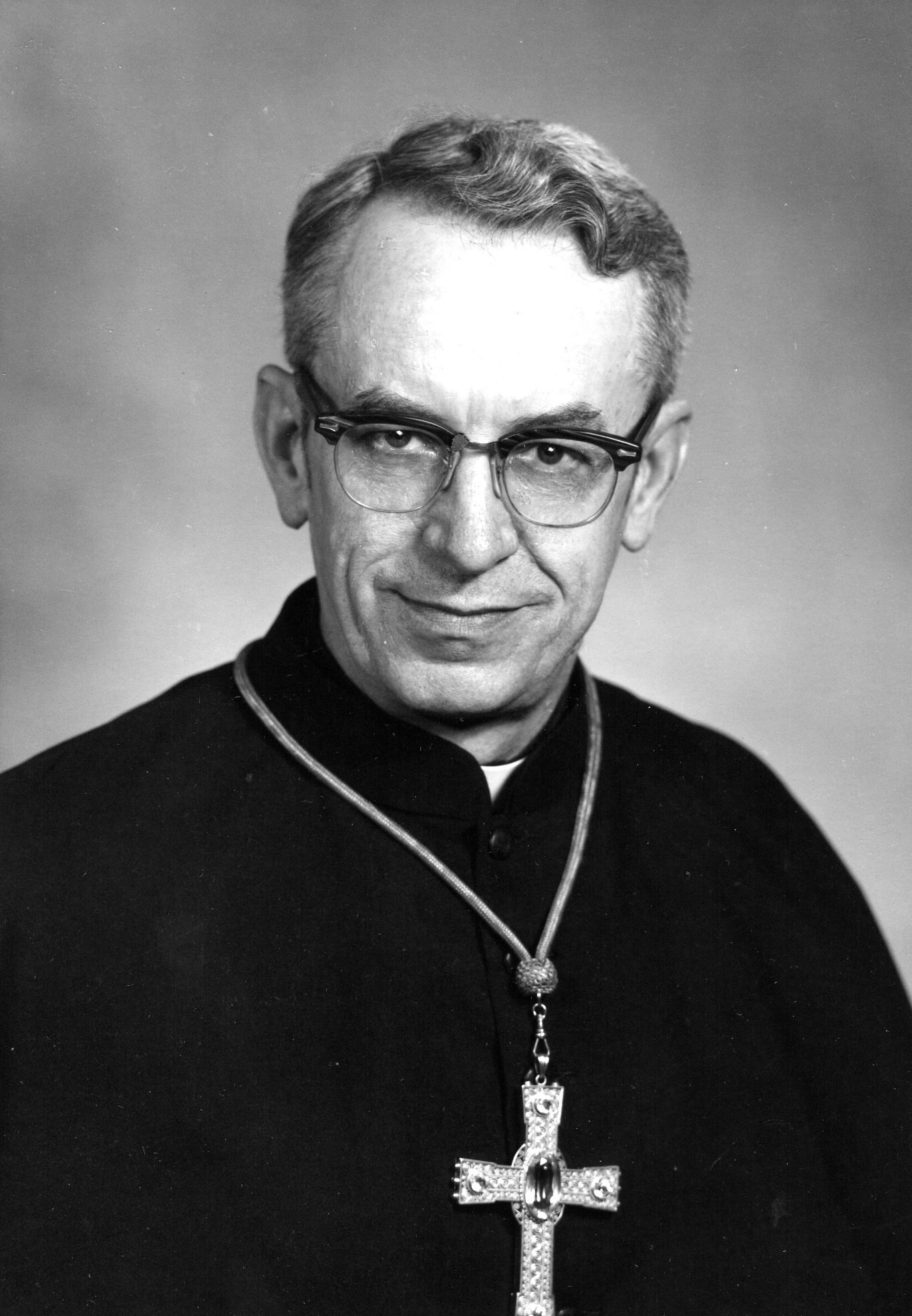St Benedict’s Abbey
Necrology
Fr. John Habiger (1905-1973)
The presence of John Habiger and his two sons certainly is and was unique in the history of our community. Father Matthew Habiger is still quite active in the works of the community. Benedict Habiger left the community for the married life. Father John and his two sons were ordained together June 14, 1968.
Fr. Malachy Sullivan (1893-1967)
“The Great White Father” so-called because of the unmistakable mane of white hair, this was Fr. Malachy. He was at different times and at the same time, athletic director at St. Benedict’s College, professor of philosophy, and weekend parish minister in Kansas City or Topeka, while teaching a full college load.
His approach to teaching was that of Socrates, the Socratic method. Loved by some, not appreciated by many. He taught in such a way that he hoped that his students might learn to think. Many did. Others were more comfortable with, let us say, a lecture approach. In his later years he did mellow some and taught History of Philosophy by the lecture method.
Bishop Louis Mary Fink (1834-1904)
Eventually the first bishop of the newly created Diocese of Leavenworth, which was carved out of the vast Vicariate Apostolic that was the charge of Bishop John M Baptist Miege, SJ, Louis Mary Fink was born in Bavaria, came to the United States and entered St. Vincent College, Latrobe, Pa. He made vows as a Benedictine January 6, 1854 and was ordained priest May 26, 1857. In 1858 he became a citizen of the United States of America.
Archabbot Boniface Wimmer chose him to be Prior both in Covington, Ky., and St. Joseph’s in Chicago, Ill. Later he was Prior of St. Benedict’s Abbey, Atchison, Kan. While a monk at Atchison he was chosen co-adjutor to Bishop Miege who assisted at his episcopal ordination at St. Joseph’s Church June 11, 1871. His health was so precarious that Bishop Foley of Chicago thought it a waste of oils to consecrate the newly chosen candidate! He lived to be nearly 70 and died on the Feast of St. Patrick, 1904.
Fr. Boniface Moll (1908-1989)
One of many monks trained to work in library science, Father Boniface along with Fathers Colman and David, worked mightily in the ground floor library workroom at the west end of what is now St. Benedict Hall, formerly the Administration Building, to maintain the reputation of the Abbey/College library as a great research library.
He served in World War II in the China-Burma-India theater of operations. He was recalled to active duty in 1949 and served in Korea, West Germany, and in the United States, before retiring in 1965 as a Lieutenant Colonel.
Fr. Columban Clinch (1903-1968)
Father Columban gathered many friends and confreres around him as he often shared the varied aspects of his life. Not able to work in the garden because of his other assignments, he regularly grew red, hot, chili peppers in pots in his room. Sometimes he brought a pocket full to the refectory, relished eating them, and shared them with his tablemates.
Fr. Henry Lemke (1796-1882)
Shortly after St. Vincent was raised to the status of an Abbey, while Abbot Boniface was in Germany, Father Henry headed west to the Territory of Kansas in December 1855. When Abbot Boniface returned to St. Vincent to find Father Henry gone, he wrote to him, saying, “O Henry, Henry, what folly has taken possession of you!” Feeling a tinge of regret, Father Henry rationalized his absence with the need for missionaries on the frontier. In February 1856, he approached Bishop John Baptiste Miege, of the Kansas Territory, to petition Abbot Boniface to allow him to stay in Kansas, and to even ask for additional monks. Those reinforcements came in 1857, thus officially founding St. Benedict’s Priory.
Abbot Owen Purcell (1931-2013)
In turning his will and life over to the care of God as he understood him, like pealing an onion away by layers, he stripped away masks, pretenses, postures to his inner self, discovering, he said, “around the essence, around the still point: God equals love equals now. In this present moment, around and round we go, and it never stops: ‘mercy, within mercy, within mercy, within mercy,’” quoting Thomas Merton.
Fr. Regis Hickey (1917-2008)
Not one to let his priestly ministry become dormant, Father Regis involved himself in the Faith, Hope, and Charity Charismatic Group in Atchison. He also dedicated some years toward being a Hospice Chaplain and was a frequent visitor to the Atchison County jail.
Father Regis loved his community of St. Benedict’s Abbey and spoke of it, its members, and its leaders in a consistently positive manner. He was tireless in serving the works of the community and within the Atchison Community. He had a great sense of humor that was disarming.
Once after being rather berated by a confrere with a short fuse for not grasping the import of a problem, Father Regis replied with a twinkle in his eye and a smile, “Thank you, Father, for tolerating my simple mind.” The confrere simply sputtered. Absent-minded at times, as we all can be, Father Regis appeared to be mindful most consistently of the charitable presence of God.
Abbot Innocent Wolf (1843-1922)
A book-length biography would be fitting to recount the life and times of Abbot Innocent. In that biography there would be parallel lives, those of St. Benedict’s Abbey and College. Father Peter Beckman has written lovingly, truthfully, and ably about the life and times of all three entities in Kansas Monks. It appears that the election of Abbot Innocent was the decisive stroke of Divine providence that gave the community hope and which turned it around.
Fr. Basil Finken (1912-2007)
Father Basil’s life as a priest-monk was very much in the tradition of the Abbey community. He served the Church and the community mainly as a pastor or chaplain. He was chaplain to the Benedictine Sisters and students at St. Scholastica High School in Chicago for some time. Earlier he had been at Sts. Peter and Paul, Seneca, St. Benedict-St. Joseph’s in Kansas City, Kan., and St Bede, Kelly, Kan. Father Basil retired at age 81, and the community was blessed with his presence.
Fr. Ignatius Smith (1926-2013)
Later, Father Ignatius transferred his vows to Holy Cross Abbey, Cañon City, Colo., a foundation of St. Vincent. While a monk there he was faithful to duties in parishes throughout Colorado, as well as serving at various times as Prior at the monastery in Cañon City. In July, 2002, when the monks of Holy Cross voted to close the monastery, Father Ignatius was appointed administrator in the period of transition. He later came to Atchison, transferring his vows here.
Throughout his life Father Ignatius he saw much change: growing up in the Great Depression, moving to Colorado, and then witnessing the closing of that monastic community. Through it all he remained faithful to his commitment as a monk and priest.
Fr. William Thompson (1918-2009)
Father William studied Canon Law at Louvain earning his doctorate in 1952 and returned to teach in the Holy Cross Abbey School of Theology until 1964. In addition to teaching Canon Law, philosophy, theology and Latin, Father William served as Prior, Procurator, Director of Clerics, Vocation Director, Oblate Director, camp counselor, coach, and in parishes in Cañon City, Pueblo and Boulder. In his later years he maintained the Holy Cross Abbey Museum, which included a gun collection, Indian artifacts, and monastic memorabilia.
Bishop Matthias Schmidt (1931-1992)
Bishop Matthias was a fearless preacher, popular retreat master, a participant in public efforts to show solidarity with the poor, such as a 10 day fast in Panama City, Panama, meetings with Bishop Oscar Ruiz of Chiapas, Mexico, home of the Zapatistas.
Fr. Bertrand LaNoue (1927-2013)
“Is my head on straight?” was not an uncommon question coming from Father Bertrand in his last months living in the Abbey infirmary. Always a sunny disposition he was never afraid to ask for help.
Father Bertrand earned advanced degrees in economics at the Wharton School of Business at the University of Pennsylvania and St. Louis University. A tough professor, he desired to see his students succeed and ushered them in gentle ways toward truth and the good that was in them. He developed relationships with his students, who with his help and mentoring, took on important jobs and careers in government, academia and business. Father Bertrand had his own economy of life teaching beyond the academic curriculum – he emphasized lessons about life: work hard, pray often, take care of your family, and enjoy life to the fullest.
Fr. Louis Kirby (1922-2013)
His six years on mission in Mexico were particularly dear to him. Upset about being called home, he complained to the local bishop, asking to transfer to the diocese. The bishop told him to write everything in a letter to his abbot, then to tear up the letter and throw it away. “That was some of the best advice that I ever had heard,” Fr. Louis said, “I was a monk after all.”
Abbot Brendan Downey (1918-1980)
True to the example of his patron, St. Brendan, he kept a small sailboat and used it fearlessly. In fact, on a trip to Minnesota to visit family, the boat capsized leaving he and his passengers to spend a night exposed to the elements while clinging to the capsized boat, luckily drifting toward the shore.
Br. Raphael Scholz (1858-1921)
Brother Raphael was born in Erfurt, Saxony, Germany, March 7, 1858, professed as a monk September 14, 1889, and died October 7, 1921. Clearly, little is known about Brother Raphael although there is some correspondence from relatives in the Abbey archives, all in German Script.






















